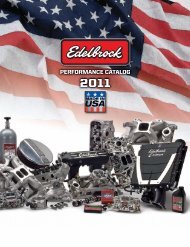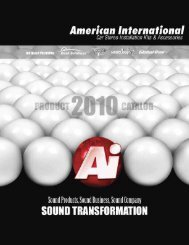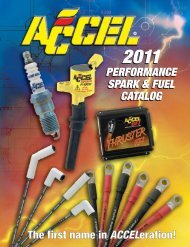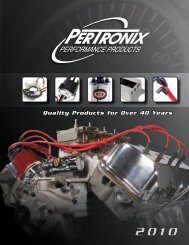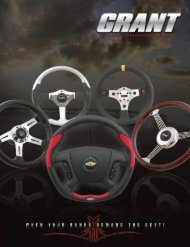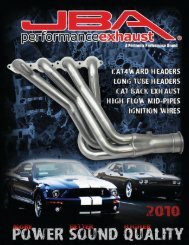2006 Ford Racing Performance Parts Catalog - Chromwerk
2006 Ford Racing Performance Parts Catalog - Chromwerk
2006 Ford Racing Performance Parts Catalog - Chromwerk
Create successful ePaper yourself
Turn your PDF publications into a flip-book with our unique Google optimized e-Paper software.
ENGINE DEVELOPMENT<br />
ENGINE INSTALLATION AND TUNING TIPS<br />
<strong>Performance</strong> engine durability is dependent on several<br />
supporting systems including the cooling system, fuel<br />
delivery system, ignition system, and oiling system.<br />
If the support systems are not adequate, poor engine<br />
performance and possible engine failure could result.<br />
OILING SYSTEM CONSIDERATIONS/<br />
COMMON PROBLEMS<br />
• Priming the oiling system before starting a new<br />
engine is crucial to engine life. This is important on<br />
initial start up of a new engine and if a used engine<br />
has not been run for extended periods of time.<br />
• Does the oil pan have adequate capacity? Most<br />
performance vehicles require a 7 qt. minimum<br />
capacity. All engines will benefit from increased<br />
oil pan capacity.<br />
• Does the oil pan have proper oil control baffling for<br />
the vehicle’s braking, acceleration, and cornering<br />
capabilities? Road Race cars need oil control in<br />
four directions: braking, acceleration, LH cornering<br />
and RH cornering. Drag race cars need oil control<br />
in two directions, braking and acceleration.<br />
Baffles must be designed to keep oil over the<br />
pickup screen at all times.<br />
• Is the pickup screen the proper distance from the<br />
bottom of the oil pan? If the oil pickup screen is too<br />
close to the bottom of the oil pan, it can cause<br />
cavitation. If it is too far away, it will cause the pump<br />
to draw air and minimize lubrication capacity. The<br />
pickup screen should be located .250" to .375" from<br />
the bottom of the pan. Does the design of the screen<br />
on the pickup tube create restrictions? We have seen<br />
some pickup tube screen designs that restrict oil flow<br />
as much as 75%. Wire mesh is good. Perforated<br />
metal is usually restrictive. Measure the wire size and<br />
calculate the flow area. Most aftermarket screens<br />
have less flow area than stock screens.<br />
• If using a remote oil filter mount or oil cooler,<br />
make sure that all of the components are large<br />
enough to eliminate any restrictions to oil flow.<br />
Many Cobra replica kit cars use components<br />
that are too restrictive.<br />
• Undersize oil lines commonly restrict oil flow.<br />
• The more bends/turns in an oiling system,<br />
the more restrictions are created.<br />
• Poorly designed remote filter mounts and<br />
adapters can create restrictions.<br />
• Be sure that the oil cooler flows enough oil<br />
to meet the engine’s requirements.<br />
• Never reuse a used oil cooler. Debris gets<br />
trapped and cannot be cleaned out.<br />
• Poorly designed oil filters can cause a restriction.<br />
• Many oil systems only flow one way. Connecting the<br />
remote oil filter or oil cooler lines backwards can<br />
cause engine damage/failure.<br />
IGNITION SYSTEM CONSIDERATIONS/<br />
COMMON PROBLEMS<br />
• The ignition system must deliver a properly timed<br />
spark. There are a lot of factors that determine when<br />
the spark should be delivered. The most common<br />
factors include: compression ratio, fuel quality, fuel<br />
octane rating, combustion chamber design, engine<br />
operating temperature, power adders such as NOS<br />
or supercharger, inlet air temp, altitude, and load.<br />
• Avoid too much or too little timing for your engine<br />
combination.<br />
• Avoid hooking up the vacuum advance to intake<br />
manifold vacuum instead of ported vacuum.<br />
34 Tech “Hot Line” (586) 468-1356<br />
• Avoid inductive crossfire created by improper plug<br />
wire routing. Separate plug wires on cylinders that<br />
fire in sequence.<br />
• Improper timing can damage pistons, rod bearings,<br />
head gaskets, and many other engine parts.<br />
• Typical total mechanical advance timing at<br />
4000 RPM for <strong>Ford</strong> <strong>Racing</strong> <strong>Performance</strong> <strong>Parts</strong> crate<br />
engines: 5.0L: 36° to 38°, 347/351: 34° to 36°,<br />
392/460/514: 30° to 32°.<br />
FUEL DELIVERY CONSIDERATIONS<br />
• Size of fuel pump, size of fuel line, fuel pump<br />
placement, fuel filter placement, fuel filter size,<br />
injector size, fuel rail size, fuel pressure, jet size,<br />
and baffling in the fuel tank.<br />
• Does the fuel system maintain full pressure<br />
at peak engine horsepower in high gear?<br />
Altitude, air temperature, and fuel characteristics<br />
including quality, specific gravity, and octane rating, will<br />
affect your jetting requirements. Engine efficiency and<br />
Brake Specific Fuel Consumption (BSFC) also have an<br />
effect. Here are some examples of a Holley 750 CFM 4V.<br />
Jetting Jetting<br />
Octane Temp. Altitude Front Rear<br />
94 80 F 0 ft. 81 86<br />
Aviation 100LL 80 F 0 ft. 81 84<br />
110 Race 80 F 0 ft. 78 83<br />
94 80 F 3000 ft. 76 81<br />
94 80 F 6000 ft. 73 77<br />
94 40 F 0 ft. 84 89<br />
94 120 F 0 ft. 78 83<br />
As you can see by these examples, jet requirements can<br />
vary a lot depending on fuel, altitude, and temperature.<br />
Oxygenated fuels are available in some states and can<br />
dramatically affect your jetting requirements. Make sure<br />
you get your jetting correct. Aviation fuel is lighter and<br />
will require richening an engine in relationship to its<br />
requirement with pump gas. We have found in the dyno<br />
testing of our crate engines that 1 point richer on air/fuel<br />
ratio equals only a few percent less power. Running an<br />
engine as lean as possible produces the best power<br />
but also increases combustion temperatures and<br />
the chances of engine damage.<br />
COMMON PROBLEMS<br />
WITH FUEL DELIVERY SYSTEMS<br />
• Do not mount an EFI electric fuel pump so it has<br />
to draw fuel from the tank. This creates negative<br />
pressure in the fuel line allowing the fuel to boil<br />
at a lower temperature.<br />
• The pump must be mounted in the tank<br />
or in a location so that it is gravity fed.<br />
• If the fuel rail is too small and you have large<br />
injectors, this can create a pulse in the fuel rail<br />
allowing fuel starvation on some cylinders.<br />
• Fuel should be pushed through the fuel filter.<br />
Pulling fuel through a filter can cause cavitation.<br />
If a filter is to be used on the inlet of a rail-mounted<br />
fuel pump, a filter rating of 160 microns MINIMUM<br />
should be used.<br />
• It takes approx. 1/2 lb. of gasoline to support<br />
1 HP. This is commonly referred to as a .5 BSFC.<br />
You should always err in the safe direction of<br />
larger when sizing your injectors and fuel pump.<br />
COOLING SYSTEM CONSIDERATIONS/<br />
COMMON PROBLEMS<br />
• Higher horsepower requires more cooling capacity.<br />
• When the fill point of the cooling system is not<br />
the highest point, air pockets are created. The<br />
air pockets then create hot spots, and the hot spots<br />
promote improper combustion, which can cause<br />
engine failure.<br />
• Improper pulley size makes the fan and water pump<br />
turn too slow or too fast. Production water pumps<br />
are normally run at 20% over engine speed and do<br />
not perform well over 5000 engine RPM. Underdrive<br />
pulleys generally reduce water pump speed to 85%<br />
of engine RPM and may not provide enough water<br />
flow to cool the engine.<br />
• The radiator must have enough area to dissipate<br />
the heat being generated by the engine.<br />
• If the fan size is too small, it will not move enough<br />
air across the radiator so it can properly dissipate<br />
the heat being generated. Fan shrouds increase<br />
the effectiveness of the fan significantly.<br />
• Radiator location can affect airflow through the<br />
radiator at different vehicle speeds.<br />
FLYWHEEL, CONVERTER AND<br />
TRANSMISSION PROBLEMS<br />
• Installing the wrong flywheel for the balance factor<br />
of the engine will cause vibration and eventually<br />
damage the engine.<br />
• Wrong length input shaft or “stack-up height”<br />
can force the crank forward, damaging the<br />
engine thrust bearing.<br />
• Improperly installing the torque converter can force<br />
the crank forward, damaging the engine thrust<br />
bearing. This is most commonly caused by<br />
improperly locating the torque convertor drain plug<br />
in the flexplate.<br />
• If the torque converter balloons, it can force the<br />
crank forward, damaging the engine thrust bearing<br />
and the transmission. Most high-performance torque<br />
converters have anti-ballooning features.<br />
• Damage to the thrust bearing can happen in<br />
seconds!<br />
MISCELLANEOUS PROBLEMS<br />
THAT CAN DAMAGE A ENGINE<br />
• Dropping nuts, bolts, washers or foreign materials<br />
down the intake. We have seen this more than once.<br />
• Reusing an intake off an engine that had broken<br />
parts in a cylinder. The parts can get bounced up<br />
into the intake manifold, carburetor or air cleaner<br />
(pieces of piston, or piston rings etc.). When you<br />
put your used intake on your new engine and start<br />
it, the pieces are drawn in and damage your engine.<br />
• Bead-blasting an EFI intake. You will NEVER get<br />
all of the blasting media out. When the engine is<br />
started, it draws the blasting media into the cylinders,<br />
destroying the engine.<br />
• Improperly torquing fasteners when installing new<br />
parts to your engine. Over-torquing of the intake<br />
manifold bolts to the cylinder head on 302 and 351W<br />
engines can cause head gasket sealing problems.<br />
• Installing distributor gears at the incorrect height,<br />
and gears made of the wrong material. We have<br />
seen this a lot on remanufactured distributors<br />
as well as popular aftermarket manufacturers<br />
of distributor assemblies. Use cast iron gears<br />
for cast iron flat tappet cams, and steel gears<br />
for steel hydraulic roller cams.



